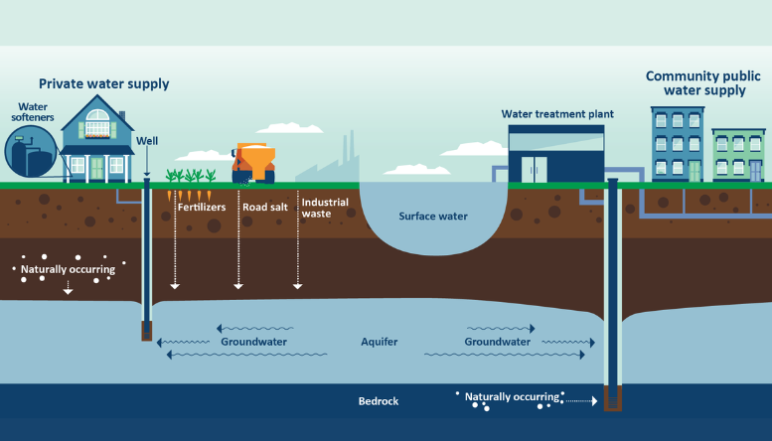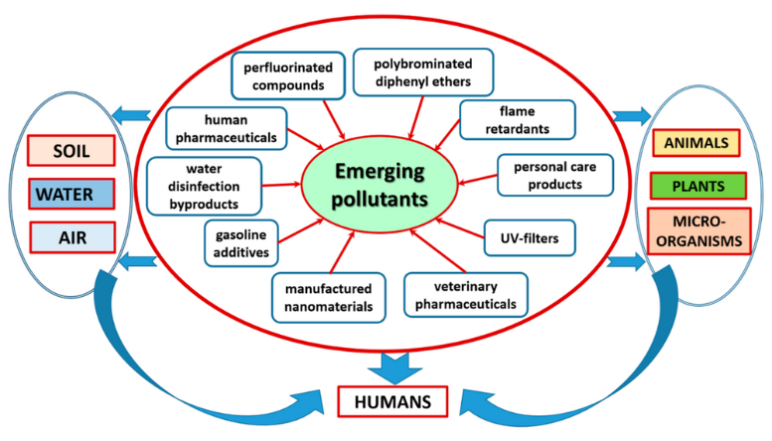Our Research Multiplexed motion-amplified microbead sensors for rapid measurement and monitoring of trace contaminants in water

Chemicals can contaminate water sources through a number of pathways. They often have health impacts at trace levels of concentration that are difficult to measure outside of the laboratory. This project aims to develop field-portable, low-cost devices to measure multiple chemical contaminants in water. Credit - Michigan Department of Health and Human Services

There are a large number of emerging contaminants whose impact on health and ecosystems is not fully understood. This project aims to develop field-portable devices to better monitor such contaminants in a multiplexed manner. Credit - Vasilachi, I.C.; Asiminicesei, D.M.; Fertu, D.I.; Gavrilescu, M. Occurrence and Fate of Emerging Pollutants in Water Environment and Options for Their Removal. Water 2021, 13, 181. https://doi.org/10.3390/w13020181

Chemical contamination from industrial activity and other sources can also affect aquatic ecosystems. Therefore, the facile monitoring of chemical contaminants in waste discharge streams and water bodies is essential. Credit- Photo by Yogendra Singh from Pexels
Principal Investigator
Rohit Karnik
- Abdul Latif Jameel Professor of Water & Food
- Director of J-WAFS
- Department of Mechanical Engineering
Rohit Karnik is the Abdul Latif Jameel Professor of Water & Food in the Department of Mechanical Engineering at MIT where he leads the Microfluidics and Nanofluidics Research Group. His research focuses on the physics of micro- and nanofluidic flows and the design of micro- and nanofluidic systems for applications in water, healthcare, energy, and the environment.
As of 2025, Karnik also serves as the director of J-WAFS, where he leads J-WAFS’ research agenda and priorities, and supports proposal review processes, project oversight, and interactions with corporate partners.
Challenge:
Can we measure multiple trace and emerging contaminants in water with high sensitivity in a low-cost, integrated field-portable device?
Research Strategy
- Develop bead-based assays for a few representative trace contaminants ranging from heavy metals to pesticides
- Implement assays in standalone point-of-use device and demonstrate sample-to-answer analysis in spiked natural water samples
- Examine device shelf-life and longevity towards establishing life-time limits and initial feasibility for continuous monitoring of contaminants in piped or surface water systems
Project description
Water pollution is a global health crisis that causes over a million deaths every year. Conventional methods for monitoring water quality, such as field test kits and high-end instruments, are limited in their ability to detect trace contaminants, understand contamination events, and respond to these events in real-time. This is because current, conventional methods are often low sensitivity, expensive, and difficult to deploy in the field.
Karnik and his team plan to develop bead-based assays for monitoring a few representative trace and emerging contaminants in water, ranging from heavy metals to pesticides. Their system will work by observing the motion of micron-sized beads using low-powered microscopy in a simple, self-contained, and portable format. This will make the test suitable for field studies and continuous monitoring. Inspired by the efficacy of bead-based sensors in healthcare, this approach has the potential to increase the ease and reach of detecting and quantifying trace contaminants in water for personal to industrial scale applications.
Publications
More than magnetic isolation: Dynabeads as strong Raman reporters toward simultaneous capture and identification of targets
Jongwan Lee, Marissa McDonald, Nikiwe Mhlanga, Jeon Woong Kang, Rohit Karnik, and Loza F. Tadesse, J Raman Spectrosc, 2023
Iron oxide xerogels for improved water quality monitoring of arsenic(iii) in resource-limited environments via solid-phase extraction, preservation, storage, transportation, and analysis of trace contaminants (SEPSTAT)
Michael S. Bono, Jr., Emily B. Hanhauser, Chintan Vaishnav, A. John Hart, and Rohit Karnik, Analytical Methods, 2021
News
Additional Details
Impact Areas
- Water
- Food
Research Themes
- Sensors & Monitoring
Year Funded
- 2023
Grant Type
- Seed Grant
Status
- Ongoing


